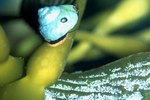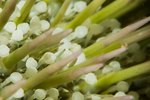
Coral reefs are diverse and broad marine communities that consist of practically countless organisms all living alongside each other. The basic framework of coral reefs is formed by coral polyps and the miniscule algae that live inside of them. Coral reefs display a variety of distinct adaptations that assist in their day-to-day functioning and survival.
Equal Advantage
The coral polyps that make up reefs serve as hosts to zooxanthellae in that they allow the algae to take shelter in their tissues. This actually is in the coral polyps' favor, too. The zooxanthellae, via photosynthesis, are capable of transforming water and carbon dioxide into carbohydrates and oxygen. Coral polyps, as a result, can employ these carbohydrates for valuable nourishment. The oxygen is also beneficial for their breathing.
Big, Happy Families
Coral polyps can easily pinpoint others that are kin to them -- those that have their specific genes. If a coral polyp encounters another and senses that it is in any way harmed or in less than optimal condition, it can send proteins and carbohydrates over as a means of strengthening the troubled party. Since their genes are no different from each other, doing this actually is advantageous for both polyps in that it enhances the chances of the successful survival of the reef environment.
Management of Higher Temperatures
Coral bleaching is an issue that arises as a result of increased temperatures in the ocean. This bleaching is perilous to coral reefs in that it affects the interplay between zooxanthellae and coral. Excessively high temperatures stop zooxanthellae from providing sustenance, which triggers their departure from the corals. When zooxanthellae vacate coral polyps, it abruptly turns the organisms white as if they were bleached. While polyps are clear in "color," their skeletons are white. Bleaching not only has the power to destroy coral entirely, it can also drastically slow down its development. Corals that inhabit warm waters can handle elevated temperatures a lot better than their counterparts in colder locales. Corals that hail from warmer geographic locations require especially high water temperatures to undergo bleaching -- a definite plus for their ongoing survival.
The Support System of Tentacles
Coral polyps are individually equipped with their own set of tentacles. Their tentacles are located by their mouths and serve two extremely important functions for their survival. They not only can seize tiny zooplankton for meals, they also can protect coral polyps from possible dangers. The ends of their elongated tentacles have stinging abilities.
References
- SeaWorld: Corals and Coral Reefs: Adaptations for an Aquatic Environment
- Encyclopedia of Adaptations in the Natural World; Adam Simmons
- Defenders of Wildlife: Coral Reef
- Life and Death of Coral Reefs; Charles Birkeland
- EPA: Coral Reef Protection: What Are Coral Reefs?
- Stanford University Microdocs: Coral and Zooxanthellae Algae
- EcoKids: Coral Reefs
- The Nature Conservancy: Coral Bleaching: What You Need to Know
- OceanWorld: Coral - Animal, Mineral or Vegetable?
- SeaWorld: Corals & Coral Reefs: Physical Characteristics
Resources
Photo Credits
-
Photodisc/Digital Vision/Getty Images




